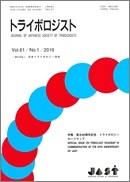63 巻, 2 号
特集・軸受のトライボロジー
選択された号の論文の14件中1~14を表示しています
- |<
- <
- 1
- >
- >|
会告
-
2018 年 63 巻 2 号 p. K2
発行日: 2018/02/15
公開日: 2018/02/15
PDF形式でダウンロード (1004K)
目次
-
2018 年 63 巻 2 号 p. M2
発行日: 2018/02/15
公開日: 2018/02/15
PDF形式でダウンロード (213K)
連載・トライボロジーを語る
-
2018 年 63 巻 2 号 p. 67
発行日: 2018/02/15
公開日: 2018/02/15
PDF形式でダウンロード (481K)
特集・軸受のトライボロジー
-
2018 年 63 巻 2 号 p. 68
発行日: 2018/02/15
公開日: 2018/02/15
PDF形式でダウンロード (183K)
解説
-
2018 年 63 巻 2 号 p. 69-74
発行日: 2018/02/15
公開日: 2018/02/15
PDF形式でダウンロード (1171K) -
2018 年 63 巻 2 号 p. 75-80
発行日: 2018/02/15
公開日: 2018/02/15
PDF形式でダウンロード (1553K) -
2018 年 63 巻 2 号 p. 81-86
発行日: 2018/02/15
公開日: 2018/02/15
PDF形式でダウンロード (1062K) -
2018 年 63 巻 2 号 p. 87-92
発行日: 2018/02/15
公開日: 2018/02/15
PDF形式でダウンロード (593K) -
2018 年 63 巻 2 号 p. 93-99
発行日: 2018/02/15
公開日: 2018/02/15
PDF形式でダウンロード (1006K) -
2018 年 63 巻 2 号 p. 100-106
発行日: 2018/02/15
公開日: 2018/02/15
PDF形式でダウンロード (796K)
学術論文
-
2018 年 63 巻 2 号 p. 107-116
発行日: 2018/02/15
公開日: 2018/02/15
[早期公開] 公開日: 2017/12/28PDF形式でダウンロード (1266K) -
2018 年 63 巻 2 号 p. 117-124
発行日: 2018/02/15
公開日: 2018/02/15
[早期公開] 公開日: 2017/12/28PDF形式でダウンロード (1210K)
会のページ
-
2018 年 63 巻 2 号 p. 125-130
発行日: 2018/02/15
公開日: 2018/02/15
PDF形式でダウンロード (1322K) -
2018 年 63 巻 2 号 p. 129
発行日: 2018/02/15
公開日: 2018/02/17
PDF形式でダウンロード (395K)
- |<
- <
- 1
- >
- >|
